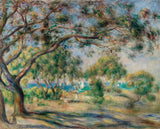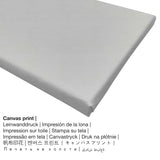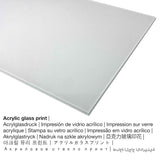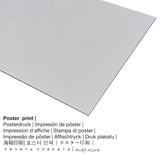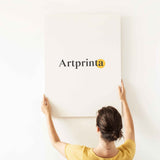Pjērs-Auguste Renuārs, 1892. gads - Bois de la Chaise (Noirmoutier) - tēlotājmākslas druka
PVN iekļauts. Piegāde aprēķināta Pie izrakstīšanās
Interesting facts about this painting painted by the modern artist with the name Pierre-Auguste Renoir
Šo mākslas darbu radīja vīrietis mākslinieks Pierre-Auguste Renoir in 1892. 120 gadu vecā mākslas darba versijas izmērs: Kopumā: 25 13/16 x 31 7/8 collas (65,5 x 81 cm). Eļļa uz audekla was applied by the painter as the medium of the work of art. Moveover, the artwork can be viewed in in the collection of Bārnesa fonds. Ar pieklājīgi no Ar Barnes fonda atbalstu, Merion un Filadelfija, Pensilvānija (licence - publisks īpašums).: . Digitālās reprodukcijas izlīdzināšana ir ainava, un tai ir attiecība 1.2: 1, which implies that the length is 20% longer than the width. The illustrator, painter, sculptor Pierre-Auguste Renoir was a European artist from France, whose style can be attributed primarily to Impressionism. The French painter was born in the year 1841 in Limoges, Nouvelle-Aquitaine, France and passed away at the age of 78 gadā 1919. gadā Cagnes-sur-Mer, Provence-Alpes-Cote d'Azur, Francijā.
Muzeja vispārīgs apraksts (© Autortiesības - autors: Bārnesa fonds - www.barnesfoundation.org)
Renoir visited Noirmoutier, an island off the west coast of France to the south of Saint-Nazaire and the estuary of the river Loire, in September 1892, during an extended period touring in northwestern France. The area around the town of Noirmoutier, on the northeast comer of the island, was a select tourist destination, and especially the Bois de la Chaise, to the north of the town, which forms the subject of Renoir's canvas. The Bois was renowned for its picturesque vistas of the sea seen through the pines, and was the site of villas and chalets for the visitors, favored more, a guidebook tells us, by aristocratic than fashionable society. Renoir stayed in the island's principal hotel, the Hotel du Lion d'Or in Noirmoutier, which had an annex and a restaurant in the Bois de la Chaise. Shortly after his visit to the island, he wrote to Berthe Morisot, "I have been to Noirmoutier; it is superb and completely southern, much superior to Jersey and Guernsey, but too far away, much too far away." To Paul Gallimard, he simply commented, "Noirmoutier's a marvel."Among the significant outdoor scenes painted by Renoir between 1888 and 1893 in the Barnes Foundation, Bois de la Chaise, Noirmoutier is closest in mood and treatment to Peninsula of Saint-Jean (BF240). Tall trees frame the view, and the eye is led through smaller trees and bushes to the open sea beyond. Two fashionably dressed women sit beneath one of the background trees, and the sea is punctuated by the white sails of recreational sailing boats. This is emphatically a landscape of recreation and leisure, without the hint of agricultural labor that appears in Peninsula of Saint-Jean. As in Peninsula of Saint-Jean, the treatment of the scene is reminiscent of the later work of Jean-Baptiste-Camille Corot, especially the supple cursive branches of the foreground trees that act as a repoussoir, and the soft dappled light. Yet Bois de la Chaise, Noirmoutier is far more highly colored than Corot's later paintings; Renoir's impressionist past is evident in the play of varied colored nuances throughout the canvas. The blues in the shadows and the sea are set off against the deep reds in the tree trunks and the warm accents on the seated figure and the sunlit ground; the greens in the foliage are also constantly variegated. However, in comparison with Peninsula of Saint-Jean, there is a greater degree of schematization and simplification in the treatment of natural forms in Bois de la Chaise, Noirmoutier. The tree branches become elegant decorative patterns, and the patches of light and shade suggest sunlight falling through foliage, but wholly without closely observed detail. In his letter to Morisot, Renoir commented on the difficulty of painting landscape: "Landscape is of one's metier, but I no longer can plant myself out of doors like a street entertainer." He added, in his comments about Noirmoutier, "If I was braver, there would be some very pretty things to paint there, as there are everywhere."In light of these comments, it seems very likely that Bois de la Chaise, Noirmoutier and another very similarly treated canvas of the Bois de la Chaise were painted in the studio, perhaps after his return to Paris. This conclusion is confirmed by the striking difference between these two canvases and a third view of Noirmoutier (Museum Oskar Reinhart, Winterthur, Switzerland); this shows a similar view through trees to the sea, with a small figure, but the trees are far more specific in their forms and the whole canvas is more rapidly and informally executed. It seems very likely that this was wholly or largely executed on the spot, and that it, and perhaps other such canvases, formed the basis for the Bames's Bois de la Chaise, Noirmoutier; the reconfiguration of the scene, back in the studio, transforms it from a picture of a specific site into a more generic idyll of outdoor leisure.
Mākslinieka detaļas
| Mākslas darba nosaukums: | "Bois de la Chaise (Noirmoutier)" |
| Klasifikācija: | glezna |
| Plaša kategorija: | modernā māksla |
| Mākslas darbu gadsimts: | 19th gadsimts |
| Izveidots: | 1892 |
| Mākslas darba vecums: | vairāk nekā 120 gadus vecs |
| Oriģināls mākslas darba nesējs: | eļļa uz audekla |
| Sākotnējie izmēri: | Kopumā: 25 13/16 x 31 7/8 collas (65,5 x 81 cm) |
| Muzejs / kolekcija: | Bārnesa fonds |
| Muzeja atrašanās vieta: | Filadelfijā, Pensilvānijā, Amerikas Savienotajās Valstīs |
| Muzeja vietne: | Bārnesa fonds |
| Mākslas darba licence: | publiski |
| Pieklājīgi no: | Ar Barnes fonda atbalstu, Merion un Filadelfija, Pensilvānija |
Izpildītāja metadatu tabula
| nosaukums: | Pierre-Auguste Renoir |
| Zināms arī kā: | Renoir August, Renoir Auguste, Auguste Renoir, Renoar Pjer-Ogist, רנואר אוגוסט, Renoir Pierre Auguste, a. renoir, Pierre-Auguste Renoir, Renuar Ogi︠u︡st, Renoir Pierre-Auguste, Renoir Pierre August, firmin auguste renoir, רנואר פייר אוגוסט, p.a. renoir, Renoir, August Renoir, renoir p.a., renoir a., Pierre Auguste Renoir, pierre august renoir |
| Dzimums: | vīrietis |
| Mākslinieka tautība: | Franču |
| Mākslinieka profesijas: | gleznotājs, ilustrators, tēlnieks |
| Izcelsmes valsts: | Francija |
| Mākslinieka klasifikācija: | mūsdienu mākslinieks |
| Mākslas stili: | Impresionisms |
| Mūžs: | 78 gadiem |
| Dzimis: | 1841 |
| Dzimtā vieta: | Limoges, Nouvelle-Aquitaine, Francija |
| Miris gadā: | 1919 |
| Nāves pilsēta: | Cagnes-sur-Mer, Provansa-Alpi-Azūra krasts, Francija |
Atlasiet vēlamo produkta materiālu
Katram produktam mēs piedāvājam dažādu izmēru un materiālu klāstu. Mēs ļaujam izvēlēties starp šiem variantiem:
- Alumīnija dibondraksts: Aluminium Dibond prints are metal prints with an outstanding depth, creating a fashionable look with a surface , which is not reflective. The Aluminium Dibond Print is the best introduction to fine art reproductions with aluminum. For your Direct Aluminium Dibond print, we print the selected work of art right on the surface of the white-primed aluminum. The UV print on aluminium is the most popular entry-level product and is a truly modern way to showcase art reproductions, as it draws focus on the artwork.
- Plakāts (audekla materiāls): Jūsu darbs IR Klientu apkalpošana Artprinta poster print is a UV printed flat canvas paper with a slightly rough surface texture. Please note, that depending on the absolute size of the poster print we add a white margin of something between 2-6cm around the print, which facilitates the framing.
- Audekla druka: A printed canvas material stretched on a wood stretcher frame. A canvas has a unique look of three dimensionality. Further, a printed canvas creates a soft and comfy look. How can I hang a canvas print on the wall? Canvas Prints have the advantage of being relatively low in weight, which implies that it is easy and straightforward to hang the Canvas print without the help of extra wall-mounts. Because of thatcanvas prints are suitable for any kind of wall.
- Spīdīga akrila stikla apdruka: An acrylic glass print, which is often referenced as a plexiglass print, will turn your favorite original artwork into beautiful home decoration. Furthermore, it is a good alternative to dibond or canvas art prints. Your work of art is made with the help of state-of-the-art UV printing technology.
Par šo rakstu
| Produkta veids: | tēlotājas mākslas reprodukcija |
| Reprodukcijas metode: | reproducēšana digitālā formātā |
| Ražošanas metode: | UV tiešā druka (digitālā druka) |
| ražošana: | Vācu produkcija |
| Krājumu veids: | pēc pieprasījuma ražošanu |
| Paredzētais lietojums: | mājas dizains, mākslas kolekcija (reprodukcijas) |
| Attēla izlīdzināšana: | ainavas izlīdzināšana |
| Attēla malu attiecība: | 1.2: 1 - (garums: platums) |
| Ietekme uz sānu attiecību: | garums ir par 20% garāks nekā platums |
| Auduma varianti: | metāla apdruka (alumīnija dibons), akrila stikla apdruka (ar īsta stikla pārklājumu), plakātu apdruka (audekla papīrs), audekla druka |
| Audekls uz nestuvju rāmja (audekla druka) izmēri: | 60x50cm - 24x20 ", 120x100cm - 47x39", 180x150cm - 71x59 " |
| Akrila stikla apdrukas (ar īstu stikla pārklājumu) izmēru opcijas: | 60x50cm - 24x20 ", 120x100cm - 47x39", 180x150cm - 71x59 " |
| Plakātu drukas (audekla papīrs) iespējas: | 60x50cm - 24x20 ", 120x100cm - 47x39" |
| Alumīnija apdrukas (alumīnija dibona materiāla) izmēri: | 60x50cm - 24x20 ", 120x100cm - 47x39" |
| Mākslas darbu rāmji: | Lūdzu, ņemiet vērā, ka šī mākslas kopija nav ierāmēta |
Juridiska piezīme: We try in order to depict our art products as accurate as possible and to showcase them visually. Nevertheless, the pigments of the printing material and the print result may diverge slightly from the presentation on the monitor. Depending on the screen settings and the nature of the surface, colors might not be printed 100% realistically. Considering that our art reproductions are processed and printed manually, there might also be minor discrepancies in the motif's exact position and the size.
Autortiesības © - Artprinta.com

